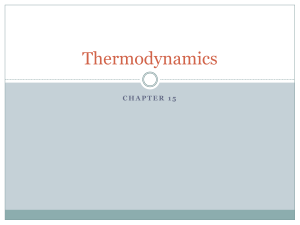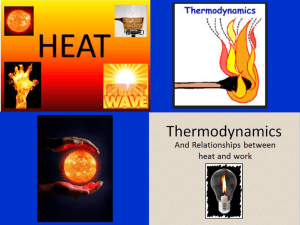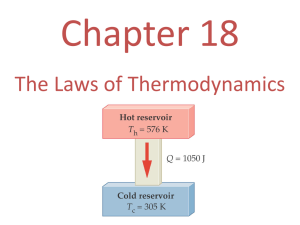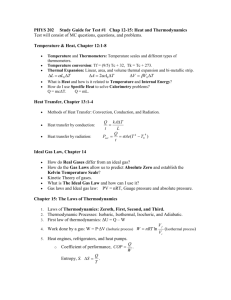Heat
advertisement
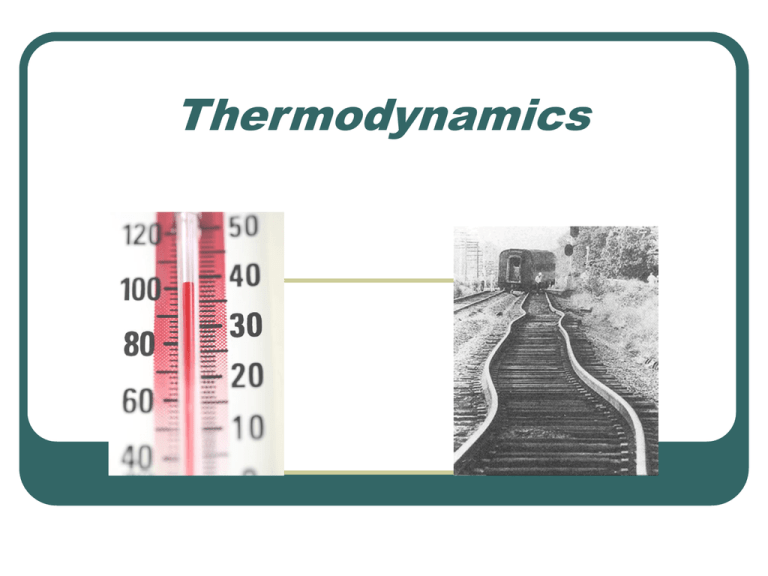
Thermodynamics Thermodynamics – What is it? The branch of physics that is built upon the fundamental laws that heat and work obey. Heat & Internal Energy Heat is energy that flows from a higher-temperature object to a lower temperature object due to the differences in temperature. Heat is positive when a system gains heat and negative when it loses heat. Internal energy is a measure of the temperature of a substance due to the kinetic energy of the individual molecules or atoms as well as potential energy of these particles . Zeroth Law of Thermodynamics Thermal Equilibrium: • • • If two object have the same temperature, then there will be no flow of heat between the two systems. If two objects are in thermal equilibrium with a third object, then they must be in thermal equilibrium with each other. When two objects are brought in contact with one another, heat will flow from the warmer object to the cooler one. Temperature Scales A common scale used for measuring and recording temperature is Celsius. • Water freezes at 0°C and boils at 100°C. To convert from °F to °C: • T (°C) = 5/9 (T(°F) – 32) The Kelvin temperature scale is of more significances than the Celsius scale. • • It is measured in the same increments as the Celsius scale, but is measured from absolute 0. The temperature at which water freezes (ice point) is 273.15 K / 0°C, and the temperature at which water boils (steam point) is 373.15 K / 100°C. Heat and Energy What is Heat? What is Energy? Is there a difference? • Yes • Heat is a measure of the transfer of energy from one • • object that is at a higher temperature to another that is at a lower energy level. Energy is a measure of the average kinetic energy of all the particles in a gas sample, the potential energy that exists between the atoms and molecules, etc. Objects do not contain heat, they contain energy. How can heat be transferred? Convection: The process of transferring heat by the bulk movement of a gas or liquid. Conduction: The process of transferring heat through a body whereby the bulk motion of the material plays no role in the transfer. Radiation: Process by which energy is transferred by means of electromagnetic radiation. Phases of Matter Matter comes in three phases – gas, liquid and solid. • • • • When a substance undergoes a phase change, the temperature does not change. Solids melt to become liquid or sublimate to become a vapor. Liquids evaporate to become a vapor or freeze to become a solid. Gases condense to become a liquid, or go through deposition to become a solid. Heat Transfer – Change in T Heat is measure of the amount of energy that flows to or from a substance is dependent on the temperature, mass of the object and the specific heat (c). Q = mcΔT • c is called the specific heat and is unique for • every substance. If ΔT is positive, then Q is positive and heat flows into the substance. Phase Changes Heat Transfer – No Change in T When a substance goes through a phase change, the temperature does not change, so the formula Q = mcΔT will not hold true. Instead: Q = mL • Where • L = Latent Heat of Transformation • For a solid to liquid L is called the heat of fusion • For a liquid to gas L is called the heat of vaporization Linear Thermal Expansion Most materials will expand when heated and shrink when cooled. • Railroad tracks, bridges and pipelines are a few examples of things that expand when heated. L = Lf – Li = Li (Tf – Ti) Where: L is the length. T is the temperature. is the coefficient of linear expansion. Example 1: Linear Expansion How much will the length of a 30 m beam change as the temperature rises from 15°C to 35°C? The coefficient of linear expansion of the steel beam is 1.2 x 10-5/°C. L = Li (Tf – Ti) L = (1.2 x 10-5/°C)(30m)(35°C - 15°C) L = 7.2 x 10-3 m = 7.2 mm Volume Thermal Expansion Since expansion should not be limited to one dimension, a similar expression to linear expansion exists for volumetric expansion. V = Vi (Tf – Ti) • For many solids, ~ 3 14.2 The Ideal Gas Law An ideal gas is an idealized model for real gases that have sufficiently low densities. The condition of low density means that the molecules are so far apart that they do not interact except during collisions, which are effectively elastic. At constant volume the pressure is proportional to the temperature. P T 14.2 The Ideal Gas Law At constant temperature, the pressure is inversely proportional to the volume. P 1 V The pressure is also proportional to the amount of gas. Pn 14.2 The Ideal Gas Law The absolute pressure of an ideal gas is directly proportional to the Kelvin temperature and the number of moles of the gas and is inversely proportional to the volume of the gas. nRT P V R Universal Gas Constant 8.314 J /( mol K ) PV nRT For an alternate representation: Since : N nN A and k PV NkT R NA k = Boltsmann’s constant = 1.38 x 10-23 J/K: 14.2 The Ideal Gas Law Consider a sample of an ideal gas that is taken from an initial to a final state, with the amount of the gas remaining constant. PV nRT PV nR constant T Pf V f Tf PiVi Ti 14.2 The Ideal Gas Law Pf V f Tf Constant T, constant n: Constant P, constant n: PiVi Ti Pf V f PiVi Boyle’s law Vf Vi T f Ti Charles’ law 14.3 Kinetic Theory of Gases •The particles are in constant, random motion, colliding with each other and with the walls of the container. •Each collision changes the particle’s speed. •As a result, the atoms and molecules have different speeds. 14.3 Kinetic Theory of Gases Using the Impulse-Momentum Theorem: v mv F ma m t t Average force Final momentum - Initial momentum Time between successive collisions mv mv mv2 2L v L 14.3 Kinetic Theory of Gases For a single molecule, the average force is: mv2 F L For N molecules moving randomly in three dimensions, the average force is: 2 N mv F 3 L root-mean-square speed F F N mv 2 P 2 3 A L 3 L volume 14.3 Kinetic Theory of Gases 2 N mv P 3 V NkT KE 2 PV 13 N mvrms 23 N 1 2 2 mvrms 2 KE 12 mvrms 32 kT • This formula shows that the kinetic energy associated with the translational motion of a particle can be determined if we know the temperature of the system. Average Speed of a Particle 3 KEavg = kBT 2 Since KEavg = ½ mv2, we can find the average speed of a particle. 3kBT vrms m Internal Energy of a Monatomic Ideal Gas Internal Energy: The sum of the molecular kinetic energy, the molecular potential energy, and other kinds of energy. U = 3/2 nRT Where: n = number of moles. R = gas constant T = Temperature (K) Note: A substance has internal energy, not “Heat”. Note: Internal energy depends only on the state of a system, and not on the method by which the system got their. Note: Formula applies to monatomic ideal gases. The 1st Law of Thermodynamics Conservation of energy says that energy cannot be created nor destroyed, but may be converted from one form to another. The 1st Law of Thermodynamics (cont.) If a system only gains heat: U = Uf – Ui = Q Heat is positive when a system gains heat and negative when it loses heat. The 1st Law of Thermodynamics (cont.) If a system only does work on its surroundings and no heat is transferred: U = Uf – Ui = -W • Work is positive when it is done by the system on the surroundings and negative when it is done on the system by the surroundings. W = PV where: P = pressure V = volume The 1st Law of Thermodynamics (cont.) A system that consists of changes to both heat (internal energy) and work simultaneously is represented by: ΔU = Uf – Ui = Q - W First Law of Thermodynamics = Law of Conservation of energy. Example 2: 1st Law of Thermo. The temperature of 3 moles of a monatomic ideal gas is reduced from Ti = 540K to Tf = 350K when 5500 J of heat flows into the gas. What is the change in internal energy (ΔU) and work (W) done by the gas? U 3 nR (Tf Ti ) 2 3 U (3.0moles )(8.314 J / mole K )(350 K 540 K ) 2 U 7100 J Using 1st Law of Thermodynamics: ΔU = Q – W • W = Q – ΔU = 5500J – (-7100J) = 12,600J Thermal Processes – Constant Pressure An isobaric process is one that occurs at constant pressure. ΔU = Q - W Since the pressure is constant, the amount of work done is: W = PV = P(Vf – Vi) ΔU = Q – PΔV Example 3: Isobaric Process 1 Gram of water is placed inside a cylinder where the pressure is maintained at 2.0 x 105 Pa. The temperature of the water is raised by 31 C°. The water is in the gaseous phase and expands by 7.1 x 10-5 m3, and has a specific heat capacity of 2020J/(kg·C°). What is the change in internal energy of the water? For an isobaric process we will use: • • Q = cmΔT for heat added. W = PΔV for work done by the gas. Using 1st Law of Thermodynamics: • • ΔU = Q - W ΔU = cmΔT - PΔV Table of Known & Unknowns Mass of water m 0.0010 kg Pressure on water P 2.0 x 105 Pa Increase in T ΔT 31C° Increase in V ΔV 7.1 x 10-5 m3 Specific Heat of H2O gas cgas 2020 J/(kg·C°) ΔU of gas ΔUgas ? ΔU = cmΔT – PΔV ΔU = (2020 J/(kg·C°)(0.0010 kg)(31 C°) – (2.0 x 105 Pa)(7.1 x 10-5 m3) ΔU = 63 J – 14 J ΔU = 49 J Thermal Processes – Constant Volume An isochoric process is one that occurs at constant volume. Since the volume (ΔV) is 0, the work is zero. U = Q - W = Q U = 3/2nR(Tf – Ti) Thermal Processes – Constant Temperature An isothermal process is one that occurs at constant temperature. U = Q - W Where W = nRT*ln (Vf/Vi) U = Q - nRT*ln (Vf/Vi) For an ideal gas: U = 3/2nR(Tf – Ti) Since the temperature does not change, U = 0. Therefore: W = Q = nRT*ln (Vf/Vi) Example 4: Isothermal Expansion 2 moles of the monatomic gas argon expand isothermally at 298 K, from the initial volume of Vi = 0.025 m3 to a final volume of Vf = 0.050 m3. Assuming that argon is an ideal gas, find the work done by the gas, the change in internal energy of the gas and the heat supplied by the gas. For an isothermal process we will use: Vf W nRT ln Vi Since the temperature does not change, the change in internal energy will be 0. 3 U nR(Tf Ti ) 0 2 Table of Known & Unknowns Initial Volume Vi 0.025 m3 Final Volume Vf 0.050 m3 Temperature T 298 K Gas Constant R 8.314 J/(kg·K) Heat supplied to gas Q ? Using the 1st Law of Thermodynamics: ΔU = Q - W • Since ΔU = 0: Q=W Vf Q W nRT ln Vi 0.050m3 Q (2moles)(8.314 J /(mole K )(298K ) ln 3400 J 3 0.025m Thermal Processes – Adiabatic An adiabatic process is one that occurs without the transfer of heat (Q = 0). U = Q - W = -W and since U = 3/2nRT W = -U = 3/2nR(Ti – Tf) If a gas expands adiabatically, then the final temperature will be lower than the initial temperature. 1st Law Relationships Specific Heat Capacities Specific Heat: A measure of the amount of heat (Q) that must be supplied to change the temperature of a substance by an amount T. • First Law: • Solving for Heat: • Using Specific Heat: • Where mc = nC U = Q – W Q = U + W Q = nCT (1) (2) Specific Heat Capacities (const. P) • From 1st Law: U = Q – W Q = U + PV 3 Q nR (Tf Ti ) nR (Tf Ti ) 2 5 Q nR (Tf Ti ) 2 • (3) Substituting (2) for Q in (3) and solving for C gives: 5 nCp (Tf Ti ) nR(Tf Ti ) 2 5 Cp R 2 Note: This relationship holds true for monatomic ideal gases. Specific Heat Capacities (const. V) • From 1st Law: U = Q – W Q = U + PV (Since V = 0, W = 0) 3 Q nR(Tf Ti ) 0 2 3 Q nR (Tf Ti ) 2 • (3) Substituting (2) for Q in (3) and solving for C gives: 3 nCv (Tf Ti ) nR(Tf Ti ) 2 3 Cv R 2 Note: This relationship holds true for monatomic ideal gases. Specific Heat An interesting outcome results when you evaluate the difference between Cp and Cv: • The reason is due to the fact that work is done under constant pressure where no work is done when the volume is constant. Cp Cv R 5 3 R R R 2 2 2nd Law of Thermodynamics Heat Flows Spontaneously from a substance at higher temperature to a substance at a lower temperature, while the reverse is not true. In other words, natural processes go in a direction that maintains or increases the entropy of the universe. Entropy: A measure of disorder or randomness of a system. Note: Reversible processes do not change the entropy of a system,….or universe. Entropy 15.8 Heat Engines A heat engine is any device that uses heat to perform work. It has three essential features. 1. Heat is supplied to the engine at a relatively high temperature from a place called the hot reservoir. 2. Part of the input heat is used to perform work by the working substance of the engine (gasoline, steam, etc). 3. The remainder of the input heat is rejected to a place called the cold reservoir. QH magnitude of input heat QC magnitude of rejected heat W magnitude of the work done 15.8 Heat Engines The efficiency of a heat engine is defined as the ratio of the work done to the input heat: e W QH If there are no other losses, then QH W QC e 1 QC QH 15.8 Heat Engines Example 5 An Automobile Engine An automobile engine has an efficiency of 22.0% and produces 2510 J of work. How much heat is rejected by the engine? e W QH QH QH W QC W e 15.8 Heat Engines QH W QC QH W QC QH W 1 QC W W 1 e e W 1 2510 J 1 8900 J 0.220 e 15.9 Carnot’s Principle and the Carnot Engine A reversible process is one in which both the system and the environment can be returned to exactly the states they were in before the process occurred. CARNOT’S PRINCIPLE: AN ALTERNATIVE STATEMENT OF THE SECOND LAW OF THERMODYNAMICS • No irreversible engine operating between two reservoirs at constant temperatures can have a greater efficiency than a reversible engine operating between the same temperatures. • Furthermore, all reversible engines operating between the same temperatures have the same efficiency. 15.9 Carnot’s Principle and the Carnot Engine The Carnot engine is useful as an idealized model. All of the heat input originates from a single temperature, and all the rejected heat goes into a cold reservoir at a single temperature. Since the efficiency can only depend on the reservoir temperatures, the ratio of heats can only depend on those temperatures. QC QH e 1 QC QH TC 1 TH TC TH 15.9 Carnot’s Principle and the Carnot Engine Example 6 A Tropical Ocean as a Heat Engine Water near the surface of a tropical ocean has a temperature of 298.2 K, whereas the water 700 meters beneath the surface has a temperature of 280.2 K. It has been proposed that the warm water be used as the hot reservoir and the cool water as the cold reservoir of a heat engine. Find the maximum possible efficiency for such an engine. ecarnot ecarnot 1 TC 1 TH TC 280.2 K 1 0.060 TH 298.2 K 15.9 Carnot’s Principle and the Carnot Engine Conceptual Example 7 Natural Limits on the Efficiency of a Heat Engine Consider a hypothetical engine that receives 1000 J of heat as input from a hot reservoir and delivers 1000J of work, rejecting no heat to a cold reservoir whose temperature is above 0 K. Decide whether this engine violates the first or second law of thermodynamics. ecarnot TC 1 TH • As far as the first law is concerned, it is not violated since in theory, all the input heat can contribute to work being done by the system on the environment. • However, the second law is violated since you can never lower the temperature to true absolute 0. Hence the efficiency cannot be truly equal to 1. Key Ideas Thermal equilibrium exists between two bodies when they both have the same temperature. Heat can be transferred through convection, conduction and radiation. The 1st Law of Thermodynamics is based upon the principle of Conservation of Energy. The 2nd Law of Thermodynamics says that heat will flow spontaneously from a substance at a higher temperature to a substance at a lower temperature. Irreversible processes lead to an increase in entropy of the universe.

